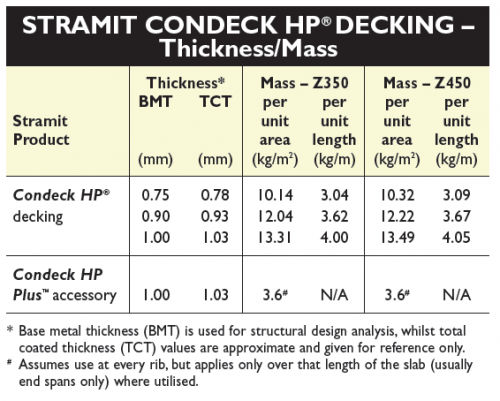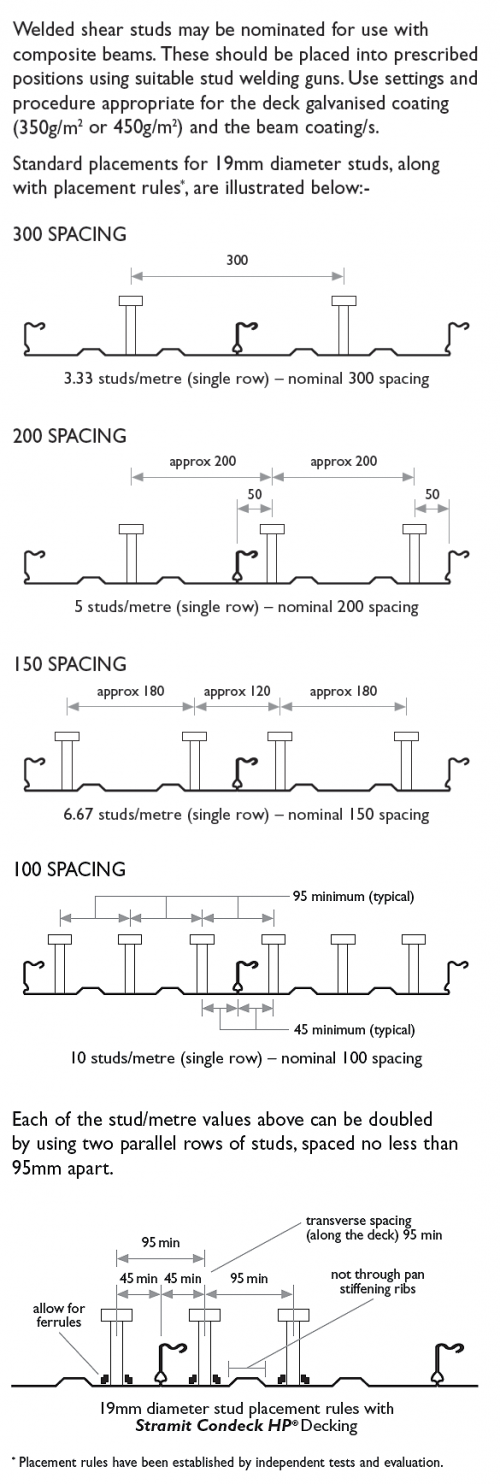- Permanent metal formwork and tensile reinforcement for suspended concrete slabs
- Supplied to site cut-to-length for speedy installation
- Enclosed ribs provide fire resistance ratings up to 4 hours
- ZAM® material for additional life in exposed environments also available
- Condeck HP® slab designer software available
Base Material Thickness (mm): 0.75, 0.90, 1.00
Total Coat Thickness (mm): 0.78, 0.93, 1.03
Where to Buy
Stramit account holders can buy Stramit Stramit Condeck HP® Composite Slab System from their local Stramit office. We do not sell direct to the public but our products are stocked by retail outlets across Australia.
Availability
This product is available Australia-wide. This product is normally supplied within 2 to 3 days of placement of order. Please talk to your local Stramit office about current lead times, particularly for large or non-standard orders.
News and Case Studies
Check out Stramit’s latest news, product releases and updates, and case studies featuring our quality Aussie-made steel products.
General Information
The Stramit Condeck HP® Composite Slab System has excellent durability. However, in applications close to marine or severe industrial environments, or closer than 450mm to the ground, please contact Stramit for a more detailed assessment of your needs, and for guidance on any precautions that may be required. Often a change to ZAM® material may be all that is required.
Avoid direct contact between galvanised steel and copper, or water run off from copper onto galvanised steel, as premature corrosion will result.
The Stramit Condeck HP® Composite Slab system comprises:
- Stramit Condeck HP® Decking – 0.75mm, 0.90mm or 1.00mm thick - Stramit Condeck HP Plus™ End Span Accessory – 1.00mm
- Stramit Edgeforma™ Slab Edging – 1.00mm (for slabs up140mm) or 1.60mm (for slabs up to 200mm), and
- Stramit Two-Part Ceiling Hanger.
We recommend placing the sheets as soon as possible after delivery. If site storage is necessary, packs should be kept dry and above ground. If sheets do become wet they should be separated, wiped and placed in the open to promote drying.
The Stramit Condeck HP® Composite Slab System can be supplied in any length up to the limit of the local Transport Authority regulations, or to practical sheet mass limitations for personnel handling.
Where practical, nominated lengths should be site measurements rather than plan dimensions. The tolerance on lengths supplied is +/- 5mm. Ensure the lengths specified are the actual required sheet length, and not the effective span used in design.
Stramit's formwork and flooring products are protected in Australia by registered designs.
Contact our technical services consultants if you require further information or advice for your local conditions and practices.
Research and development activity has involved testing at the Centre for Advanced Structural Engineering, University of Sydney; the Centre for Construction Technology & Research at the University of Western Sydney; and CSIRO.
This has included tests related to fire design, composite action, shear studs, bare steel and deflection.
Technical Information
The selection of a Stramit Condeck HP® Composite Slab System can be made directly from the span tables given in the Condeck HP Composite Decking product Technical Manual. These tables include:
- concrete compressive strengths of 25MPa, 32MPa and 40MPa
- base metal thicknesses of the Condeck HP of 0.75mm, 0.90mm and 1.00mm
- estimated maximum deflection of rib under wet concrete = span/240
- density of concrete (plus allowance for steel reinforcement) = 2500kg/m3
- total slab deflection of Span/250, and
- incremental slab deflection of Span/500 (for slabs supporting masonry partitions).
All loads have been assumed to be uniformly distributed. The slab has a uniform cross section. Partial shear connection theory is used to determine positive moment capacity and to check for slip under serviceability conditions.
Shrinkage and temperature mesh is assumed to be placed on top of decking for slabs 125mm and under and at top of slab for thicker slabs. More economical designs can be achieved by using the Stramit Condeck HP® Slab Designer software.
Actual deflection of metal decks vary significantly due to a range of practical field variables. These include concrete density, concrete placement position and levels of supports.
The Condeck HP Composite Decking Product Technical Manual includes tables for formwork spans with rib deflections of span/240 and span/150. These deflections should be regarded as nominal only.
Design of the suspended slab using the Stramit Condeck HP® Composite Slab System requires analysis of three separate functions:
- Formwork Mode – including laying of the decking, propping (if required), concrete pouring and curing, and incidental use during this time such as stacked material loading.
- Composite Mode – end use performance for both strength and serviceability criteria such as long-term deflection. Includes interactive performance with support members such as concrete band beams or composite steel beams using shear studs.
- Fire – where fire rating is required, determine the slab thickness and fire emergency reinforcement requirements. Can incorporate the intrinsic strength of fully embedded ribs in the fire resistance design.
Composite design in the Condeck HP® Composite Slab Technical Manual is based on Partial Shear connection theory for positive moment capacity. This has become recognised in Australia as the most accurate method of designing composite slabs.
The method relies upon test derived values of coefficient of friction and mechanical resistance to determine the composite strength of particular metal decks. Composite decking slabs are designed as one-way slabs.
Stramit has software available for the design of a Stramit Condeck HP® Composite Slab System. Stramit Condeck HP® Slab Designer incorporates formwork, composite and fire design considerations, and allows for many more variables and permutations than those given on the published manual.
Register here to obtain a copy of the latest software.
Maintaining the correct specification of composite decking is important to ensure that all design requirements are met. The following specification is recommended.
The concrete formwork shall be X.XXmm thick Stramit Condeck HP® Composite Slab System with 55mm high ribs spaced at 300mm centres. Material shall be G550 high-tensile steel in accordance with AS 1397, with a Z350/Z450 galvanised coating. The manufacturer shall provide independently verified data and documentry evidence enabling fully embedded rib flanges to contribute to fire emergency reinforcement.
Shear studs are to be positioned strictly in accordance with the manufacturers recommendations for the nominal spacing specified. Individual sheets shall be hinged into position in accordance with the manufacturers instructions.
Prior to concrete pouring, foot traffic and other construction loads being applied, the Condeck HP® Composite Slab System shall be propped in accordance with the manufacturers propping table. Reinforcement and concrete placement shall be as directed by the engineer.
All work is to be completed in a workmanlike manner and all dirt, mud, debris, screws, rivets, cuttings, etc are to be removed prior to concrete pouring. Props are not to be removed until authorised by the site engineer.
A NATSPEC work section is available for this product. Download
Satisfactory fire design requires confirmation of three criteria: integrity, insulation and structural adequacy.
Structural Adequacy (resistance to collapse) is generally achieved through the inclusion of Fire Emergency Reinforcement (FER) mesh within the slab. The largely embedded ribs of Stramit Condeck HP® Composite Slab System allow substantial savings in the amount of FER required. Application of a fire resistant spray coating, or fire rated ceiling, may also reduce the FER requirement.
Integrity (resistance to the passage of flame or smoke) of the slab is considered to be provided automatically by permanent, overlapping decking such as Stramit Condeck HP® Composite Slab System, although design care may be needed at ends and edges of the decking.
Insulation (resistance to excessive slab surface temperature) is normally achieved through selection of a slab of suitable thickness for the required Fire Resistance Period (FRP). Alternatively, a fire resistant spray coating can be applied to the underside of the decking, or a fire rated ceiling system installed.
Loadings are generally in accordance with As 1170.1 and AS3610:
- Stage I loading – Construction and stacked materials , and
- Stage II loading – Wet concrete (including an allowance for ponding), pattern loading, and live loads.
The construction load is assumed to be 1kPa or 3kPa over a 1.6m x1.6m area.
Stramit Condeck HP® Composite Slab System is manufactured from high-tensile (G550) steel with a Z350/Z450 galvanised coating, in full conformance with AS1397. Stramit Condeck HP Plus™ End Span Accessory is manufactured from high-tensile (G550) steel with a Z275 galvanised coating. It is also possible to supply Stramit Condeck HP® Decking with the underside COLORBOND® coated. Supply is subject to project size and lead-time.
Stramit Condeck HP® Composite Slab System is generally offered in three standard base metal thicknesses of 0.75mm, 0.90mm and 1.0mm. Other thicknesses may be supplied, dependent on lead times and availability. Stramit Condeck HP Plus™ End Span Accessory is generally offered in 1.0mm base metal thickness.

The negative reinforcement required for continuous slabs should be established by conventional design methods. It should be placed with a minimum 20mm cover to the top surface of the slab.
Section properties for Stramit Condeck HP® Decking and composite slabs are based on AS3600 and comprehensive testing. Please refer to the Condeck HP® Composite Decking product Technical Manual for details.
When used in conjunction with steel beams, Stramit Condeck HP® Composite Slab System offers the advantage of being particularly suitable for use with shear studs. The use of shear studs enables the design of highly efficient composite beams.
Stramit Condeck HP® Composite Slab System offers tremendous versatility in the number and placement of shear studs, due to its fully embedded ribs. Up to 20 studs per metre width are possible when used in double row, or 10 studs per metre width in a single row along the beam. Standard placements for 19mm diameter studs, along with the placement rules are given in the Condeck HP Composite Decking Product Technical Manual.
Installation Information
The Stramit Condeck HP® Composite Slab System requires the same degree of curing as a conventional reinforced concrete slab. Follow the guidelines of AS3610.
The concrete must be poured evenly to the panel ends on the prepared clean deck, in the direction of span of the decking. Heaping of wet concrete must be avoided.
The concrete should be placed in accordance with the requirements of AS3600 and have a minimum 28 day compressive strength of 25MPa, and slump satisfying the Engineers requirements.
As a guide, the slump should be 60-80mm for vibrator compaction. Hand compaction is not recommended. Chemical admixtures are allowed provided they are in accordance with AS3600.
Stramit Condeck HP® Composite Slab System is supplied cut to length so that cutting is generally only required around projections and cut-outs.
When cutting, use a power saw fitted with an abrasive disc or metal cutting blade. It is recommended that cuts be started with the decking laid upside down (ribs down). Then turn the sheet and, if necessary, complete the cutting of the ribs.
This method should provide the neatest finish, and minimise the risk of burred edges being exposed to the finished slab.
Stramit Condeck HP® Composite Slab System is easily placed by hinging the overlap edge of one sheet over the underlap edge of the previous sheet. If the decking is used as a platform for laying subsequent sheets, designated propping must be positioned first.
Once decking panels are laid they should immediately be secured against possible wind uplift. Typically use one fixing per pan at end supports, and fixing every third pan at permanent internal supports.
Self-drilling and tapping screws or powder actuated drive pins are commonly used. These fixings should be located adjacent to the decking ribs. In exposed conditions, additional fixing may be required.
Shear studs, if used, attached immediately after decking placement or puddle welds, will provide wind uplift resistance.
Place the shrinkage and temperature reinforcement (fabric) so that minimum cover requirements as per AS3600 is satisfied (generally 20mm to 30mm cover from top of slab or on top of deck ribs for thin slabs). Lap and tie fabric to ensure continuity in both directions.
If the slab has been designed as continuous, then additional steel reinforcement as specified by the engineer shall be provided over the supports.
Temporary propping, where required, must provide continuous transverse (across the sheet) support at the prescribed spacings. The prop bearer width must be no less than 100mm, unless established by calculation.
Continuous support is generally provided by substantial timber or steel beams supported by vertical props. All propping should meet the requirements of AS3610, including bracing. Propping bearers should not be placed higher than the permanent end support.
Temporary propping must not be removed until the slab has cured sufficiently. The propping removal procedure should be in accordance with AS3610.
Stramit recommends that good trade practice be followed when using these products, such as found in CCAA Standards Australia handbook HB67 ‘Concrete practice on building sites.
The Stramit Condeck HP® Composite Slab System provides resistance to leakage during concrete pouring. For most applications where the concrete slump is not excessive, no sealing is required.
To prevent slurry leakage (if required) just tape over the small ceiling hanger recess near the bottom of the ribs, and the two pan stiffening rib recesses, at each sheet end.
Stramit Condeck HP® Composite Slab System has the advantage of allowing placement of shear studs at 100, 150, 200 or 300mm centres along the beam. Placement rules have been established by independent tests and evaluation.

Side-lap fastening is only required if stacked construction materials are to be laid on the decking. Where required, side-lap fasteners should be at least 10x16 self-drilling and tapping screws.
These should be fixed through the trough in the rib tops, and positioned at mid span on every rib.
The edge of Stramit Condeck HP® Composite Slabs can be addressed in a variety of ways common to conventional concrete slabs. Additionally, Stramit Edgeforma™ makes a easy to use and simple edge treatment for many applications.
Edges of metal deck slabs exposed to direct or indirect rainfall must have a continuous drip feature to prevent water running to the underside of the decking. Please refer to the Stramit Condeck HP® Technical Manual for more details.
Floor penetrations can be conveniently formed by conventional formwork methods and then cut out after the concrete has set.
For large predetermined openings larger than 750mm, such as stairs and elevators, the most practical method is to supply supplemental structural framing to the support system for the Stramit Condeck HP® Composite Slab System.
Any decking containing penetrations where the total penetration exceeds 200mm must be assumed to be non-continuous, ie it must be supported or designed as a cantilever.
Holes can be cut through a Stramit Condeck HP® Slab, but this must be done with caution. Please refer to the Stramit Condeck HP® Technical Manual for more details.
Great care must be taken during construction to avoid damage from stacked materials. The formwork mode data available is based on a maximum stacked material load of 1.5kPa loaded in the pans.
Other loading cases can be determined using the software Stramit Condeck HP Slab Designer™. Refer to the engineer or the design drawings for the stacked material allowance used in design, as this often varies.
If in doubt, either do not stack materials onto the decking, or contact your local Stramit technical consultant.
It is imperative that permanent supports (steel or concrete beams, or walls) are stable and of adequate strength to withstand loadings prior to the placement of the decking.
Ensure that the end bearing width (minimum 50mm) and internal bearing width (minimum 100mm) nominated by the engineer is achieved on site.
The Stramit Condeck HP® Composite Slab System has provision for suspended ceiling installation or support of building services. A two part hanger bracket is simply inserted into the underside of any rib and held in place by the suspension rod.
The ceiling hanger is capable of supporting a load of 2.5kN. It is easier to insert the hangers before the concrete pour, although they can be inserted after if required.
Please note that the ceiling hanger performance is dependent upon concrete being in place. Performance of the ceiling hanger loaded before the concrete pour is significantly less.
Provided additional side lap fasteners are installed through the vertical web of the ribs at no more than 500mm either side of the hanger, capacity of the hanger is reduced to 0.6kN.
Take care when walking on Stramit Condeck HP® Composite Slab System, particularly if the surface is wet.
Wear suitable rubber-soled footwear at all times. Also note that there may be traces of oil present when the product is first delivered. It is possible to step either in the pans or on the ribs of Stramit Condeck HP® Composite Slab System, but when walking use only the pans. Avoid walking on the edge sheet, or on rib ends.

